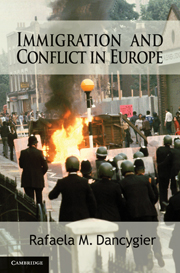Book contents
- Frontmatter
- Contents
- List of Figures and Tables
- Acknowledgments
- PART I GENERAL INTRODUCTION AND THEORETICAL FRAMEWORK
- 1 Introduction
- 2 A Theory of Immigrant Conflict
- PART II INTRODUCTION TO PART II
- PART III INTRODUCTION TO PART III
- PART IV INTRODUCTION TO PART IV
- 9 Conclusion
- Appendix A Coding Large-Scale Instances of Immigrant–Native and Immigrant–State Violence
- Appendix B Data and Variables: Immigrant Turnout
- References
- Index
- Titles in the series
1 - Introduction
Published online by Cambridge University Press: 17 November 2010
- Frontmatter
- Contents
- List of Figures and Tables
- Acknowledgments
- PART I GENERAL INTRODUCTION AND THEORETICAL FRAMEWORK
- 1 Introduction
- 2 A Theory of Immigrant Conflict
- PART II INTRODUCTION TO PART II
- PART III INTRODUCTION TO PART III
- PART IV INTRODUCTION TO PART IV
- 9 Conclusion
- Appendix A Coding Large-Scale Instances of Immigrant–Native and Immigrant–State Violence
- Appendix B Data and Variables: Immigrant Turnout
- References
- Index
- Titles in the series
Summary
What explains immigrant conflict? Why do we observe clashes between immigrants and natives in some locations, but not in others? When do cities experience confrontations between immigrants and state actors? Why are some immigrant groups likely to become targets of native opposition, while others are more often engaged in conflicts with the state? What accounts for change in immigrant conflict within locales over time?
This book explains why, where, and when immigration leads to conflict in the areas of immigrant settlement. Immigration has been changing the faces of neighborhoods, cities, and countries across Europe, North America, and beyond. The large-scale inflow and permanent settlement of migrants is no longer confined to traditional immigration countries. In 2005, the share of foreign-born residents reached 12.5 percent in Austria and 12.1 percent in Germany, compared with 12.3 percent in the United States. In many other European countries approximately one in ten residents is born abroad (see Figure 1.1). Moreover, countries that have long been exporters of labor, such as Spain and Italy, have begun importing foreign workers and their families in large numbers. The magnitude of immigration manifests itself even more strikingly at the local level: Amsterdam, Brussels, Frankfurt, London, and New York are just some of the cities whose foreign-born residents constitute more than one-fourth of the population (Migration Policy Institute 2008).
- Type
- Chapter
- Information
- Immigration and Conflict in Europe , pp. 3 - 20Publisher: Cambridge University PressPrint publication year: 2010



